- Home
- slideshows
- miscellaneous
- The best sunscreen
The best sunscreen
The best sunscreen overall

The best spray-on sunscreen
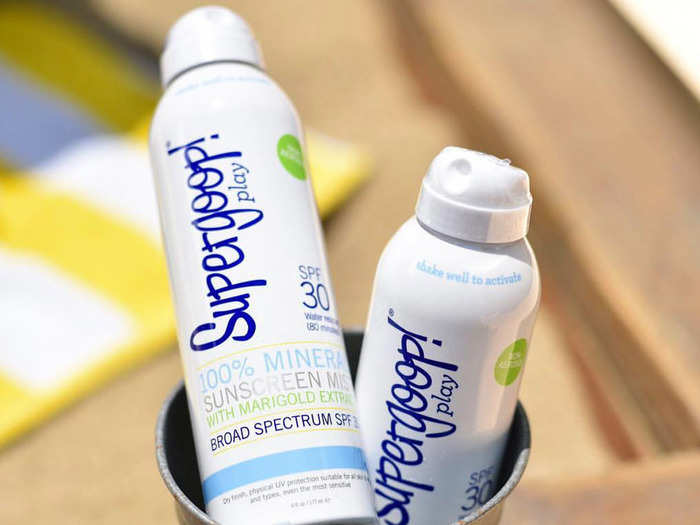
Generally speaking, spray-on sunscreens aren't the best because we tend to spray them on too thinly and miss spots entirely. Mineral sunscreens are even more troublesome because they don't tend to spray well in the first place, and often dry out to the point of becoming impossible to use.
Supergoop's Mineral Sunscreen Mist works fairly well, but it's light-duty, and while it rubs in with hardly any residue, it only contains 12% zinc oxide, which falls short of the recommended 18% (or more). Still, it's the best we've found.
Our previous pick, from Bare Republic, had a combination of 15% zinc oxide and 4.3% titanium dioxide, which seems just right, and spreads evenly, but still left a white cast. Then, over time, our sample suddenly began to thicken to the point of nearly solidifying, and we couldn't get it to spread or rub in.
What you can do with Supergoop's Mineral Sunscreen Mist is vigilantly apply it frequently (maybe every hour) to make up for the lower SPF rating.
In the end, most of us aren't trying to look pasty on the plage, and we get that. Supergoop strikes a happy medium between how much people care about protecting their skin and putting themselves at risk for skin cancer, how much they don't want that white cast. The Huffington Post, The Strategist, and Glamour all love Supergoop for this reason. Give Supergoop a go, but make sure to reapply often.
Editor's note: We're in the process of testing and reviewing Supergoop's Play sunscreen, which comes with ample zinc oxide and a touch of titanium dioxide. We like it so far, and will report back soon. Read more about our findings so far at the bottom of this page.
Pros: Applies easily and cleanly, works fairly well
Cons: Expensive, not quite the recommended amount of active ingredients in most sunscreens
The best cheap sunscreen
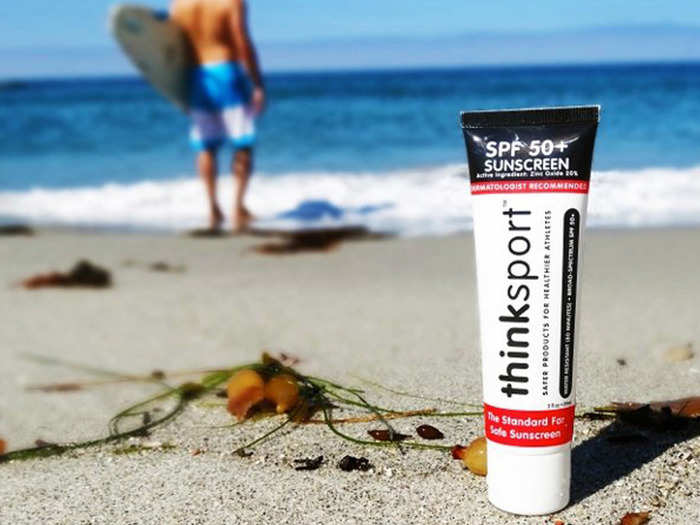
Zinc oxide and purified water are the main ingredients in Thinksport's Sunscreen, which is a great option for hypoallergenic and eco-conscious buyers alike. Although it can leave you a bit pasty — as practically all mineral-based sunblocks do — it does eventually blend while still managing to offer superior UVA and UVB protection.
Amazon buyers complimented it on everything from its ability to blend and its high rating from the Environmental Working Group (EWG) to its affordable price per ounce. Some complain that it dries their skin out too much, which zinc oxide tends to do, and many others had trouble rubbing it in.
If you find blending zinc oxide into your skin to be a nuisance, you might go for Thinksport's Everyday Face, which comes with a natural tint and blends with most complexions. Just take care around clothes, car seats, or anything else you want to avoid staining. To that end, it probably won't do too well in water.
We're also a big fan of Badger's array of sunscreens, especially for watersports — and the SPF 34 Anti Bug Sunscreen is my personal favorite, though I have no qualms about going outside looking like a streaky white mess.
Badger's sunscreen becomes especially handy where tropical, disease-ridden mosquitoes abound, but it's probably not for everyone. We're looking into other options, but this is a wonderful, industrial-strength option for deeper, buggier expeditions.
Pros: Affordable, superior protection, plastic-free container
Cons: Requires some effort to rub in
The best cosmetic sunscreen
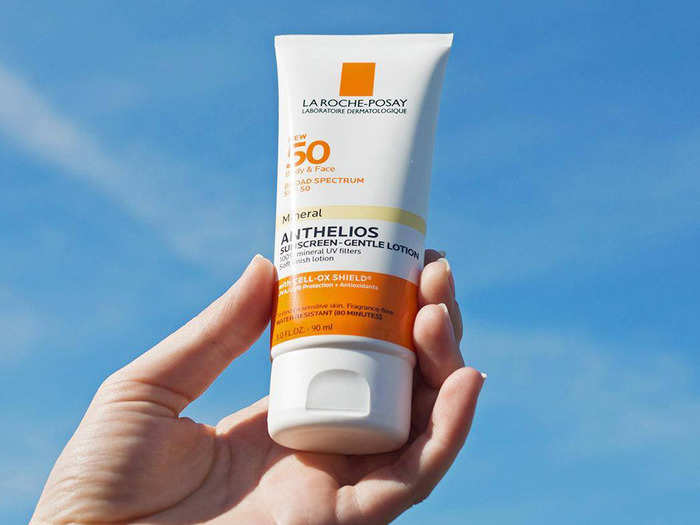
Physical sunscreens — formulas that block UV rays by forming a sort of shield over the skin — can be really uncomfortable. Many of them feel heavy, pill up when you try to rub them in or apply makeup on top, or give the skin, especially darker complexions, a strange white cast.
La Roche-Posay Anthelios Ultra-Light Mineral Sunscreen SPF 50 delivers the UVA/UVB and free radical protection you can expect from physical sunscreens without the negative side effects. The formula contains 6% titanium dioxide and 5% zinc oxide to shield the skin from sun damage and an antioxidant complex called senna alata to protect from environmental damage.
This sunscreen comes in a lightly tinted version or a non-tinted version. The tint will prevent white cast and flashback in photos, but it's not a foundation. There's not really any coverage. You can apply other makeup over the top, so you don't have to worry too much about color-matching. The tint is really there to make it easier to wear if you have a medium to deep skin tone. If you opt for the non-tinted, you'll get more of a traditional white liquid sunscreen formula that absorbs easily into the skin.
La Roche-Posay Anthelios sunscreens are popular with both shoppers and experts. This one, in particular, has been recommended by Refinery29 Senior Beauty Editor Lexy Lebsack. She writes, "It's incredibly light and soaks in immediately, but it's also hydrating enough to take the place of my morning moisturizer."
The brand's sunscreens have recently been endorsed by The Strategist, Allure, Health, Elle, and Redbook. — Jada Wong, Insider Picks Editor
Pros: Tinted and non-tinted, protects from UVA/UVB rays and free radicals, water-resistant up to 40 minutes, safe for sensitive skin
Cons: Pricey, probably too little protection for direct/intense sunlight (the FDA and EWG recommend about 20% of zinc oxide or titanium dioxide)
The best sunscreen for a day in the water
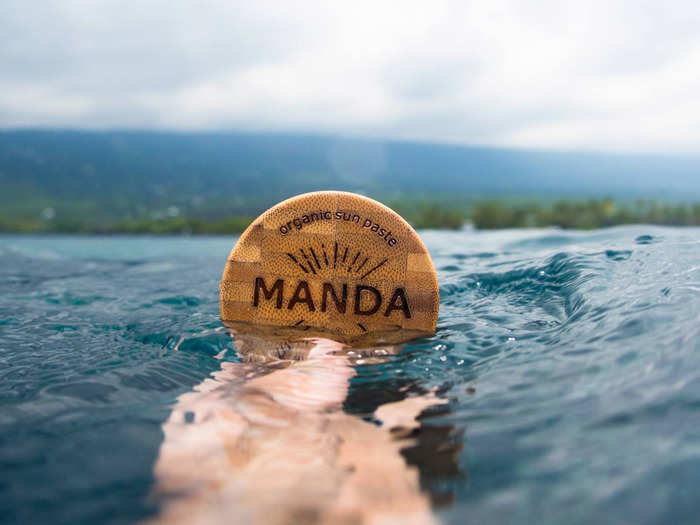
Most sunscreens, even the ones that claim water-resistance, wash off pretty quickly in the water, and especially in the surf. Surfers and swimmers need something that water won't ablate. Manda doesn't wash off, and to that point, doesn't run at all, so you shouldn't find it burning your eyes.
Cake this stuff on. That's the point. Don't be embarrassed. No matter how hard you try, it will not rub in, and if it does, you've probably spread it too thin, or at least beyond its optimal efficacy. For that reason, I wouldn't recommend it for running about town, but it works wonders for aquatic enthusiasts, as well as perspiring, landlubbing athletes who spend prolonged periods of time in intense and/or direct sunlight.
And while khaki/beige might not be the most flattering hue to smear over any shade of human flesh, it sure beats ghost white or atomic orange. Although Manda's 20% concentration of zinc oxide can simultaneously dry out your skin and clog your pores, Manda has taken the unique step to include what might be the oldest sunscreen known to humankind.
Thanaka, the mustard-yellow paste that gives Manda its tint, is made from a small, shrubby, southeast Asian tree by the same name, and was made popular over two millennia ago in Myanmar for a bevy of dermatological reasons.
Apart from being a mildly effective natural sunscreen, thanaka is a regenerative antioxidant and an anti-bacterial, anti-fungal moisturizer that is also regularly used in Myanmar to treat acne. Further, it's likely that it inhibits the enzyme tyrosine's production of melanin, which might help reduce the development of melanoma and even brighten your complexion — not that it needs brightening.
This sunscreen is also — weirdly — entirely food-safe. I personally tested that claim, and may or may not have reached for seconds.
Pros: Familiar, all-natural, and food-safe ingredients
Cons: Expensive (but not bad if you only use it on your face)
The best sunscreen for kids
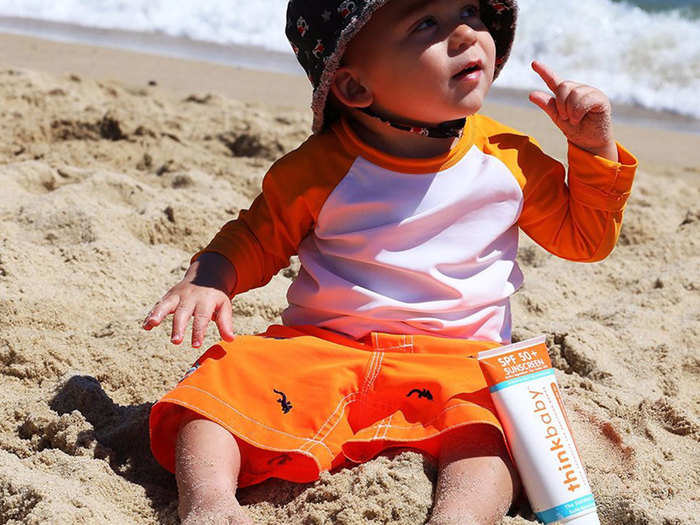
Given a number one rating by the Environmental Working Group, Thinkbaby Safe Sunscreen SPF 50 uses mineral zinc oxide to block UVA and UVB radiation, along with a host of other natural, skin-soothing ingredients such as aloe, jojoba oil, Vitamin C, and raspberry seed oil.
This sunscreen is free of all potentially harmful chemicals, including Nanoparticles that might enter the bloodstream through the skin. It's safe for delicate skin, even on babies as young as six months old. It's important to note that no sunscreen is allowed to advertise as safe for children younger than six months of age. Pediatricians recommend babies that young be kept out of the sun altogether.
Thinkbaby Safe Sunscreen goes on thick and does leave a white cast, as is typical with most zinc oxide sunscreens. It doesn't dry the skin, however, or feel especially greasy, although it does leave skin shiny.
Pros: No potentially harmful chemicals, pleasant smell, effectiveness
Cons: Expensive, leaves skin shiny, white cast
The best chemical sunscreen (if you must)
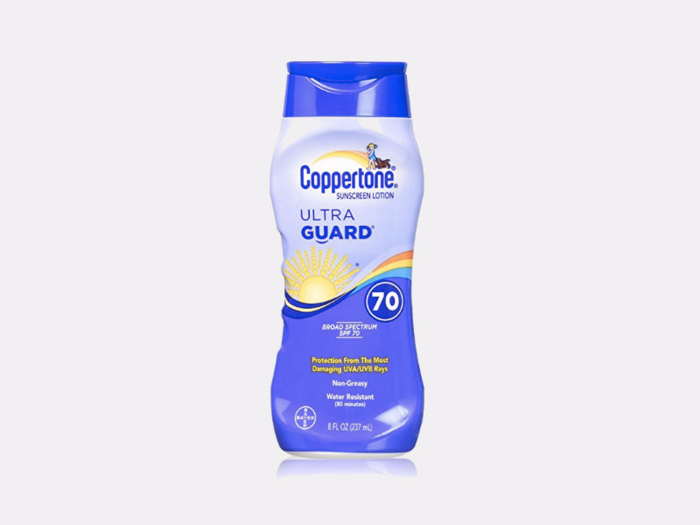
Non-greasy, hypoallergenic, water-resistant, and without added fragrance, Coppertone Ultraguard SPF 70 is a great way to protect your skin whether you're spending the day at the beach, playing a game of softball at the park, or just taking your dog for an afternoon walk.
It doesn't have a strong scent and best of all, it dries quickly and cleanly without that ghostly white cast some sunscreens leave. Although it is water-resistant, you should still reapply after swimming, of course.
Expert reviewers and buyers alike approve of the sunscreen. Coppertone's Ultraguard SPF 70 is the number one recommended sunscreen at Wirecutter. The reviewers praise the sunscreen for its strong protection and easy application. They also like the plastic bottle, because it's easy to hold and close, even with wet or slippery hands.
Consumer Reports also gives this sunscreen high marks with an overall score of 94 out of 100. They found it to be excellent at blocking both UVA and UVB rays, and also very good at performing at the stated SPF of 70.
Editor's Note: Chemical-based sunscreen is generally okay, as long as you're not hyper-allergic to organic compounds like oxybenzone or octinoxate, but please keep these damaging chemicals well away from waterways, where they have been linked to high mortality among corals, along with a growing list of other aquatic creatures.
Pros: Effective performance, non-greasy feel, hypoallergenic, reasonable price
Cons: Highly toxic to reefs, waterways, the creatures that call them home, and you
Other brands and products we considered, and what we look forward to trying

Badger (available at Amazon): Badger is one of my personal favorite sunscreen brands, and I find it to be among the absolute most effective sunscreens, but it can be extremely difficult to rub in (let alone squeeze out of the bottle), and it does leave a noticeable cast. If you're really out in the elements though, this is a solid pick.
Bare Republic (available at Amazon): Our previous top pick for a spray-on mineral-based sunscreen, Bare Republic worked wonderfully until it didn't. We gathered it might be something about heavy (and soft) metals being put through pressure, but it finally became so dry that we weren't able to spread it at all.
Blue Lizard (Available at Amazon): Blue Lizard is a popular sunscreen around the world, and while we like that it rubs in well, and that its ingredients include both titanium dioxide and zinc oxide, the 5% and 10% concentrations, respectively, fall a little short of what's advised by The Sunscreen Doc. Insider Picks editor Jada Wong points out, though, that she's happy to reapply more frequently if it means she gets to use an easy-to-apply sunscreen that rubs in well. Still, we don't like that the brand doesn't openly advertise the concentrations of active ingredients in their formula.
CeraVe (available at Amazon): CeraVe applies well, but it's another one of those brands that offers formulas that don't include a high enough concentration of active ingredients. This product, for example, which is considered SPF 50, only offers 9% titanium dioxide and 7% zinc oxide.
MyChelle Sunshield (available at Amazon, $16.50): We liked wearing MyChelle. It went on easily and seemed to work well, but there's a long list of ingredients, some of which are allergens and immunotoxins. If your skin isn't too sensitive, you might give it a go.
Supergoop! (available at Amazon): Supergoop!'s Mineral Sunscreen Mist works fairly well, but it's light-duty, and while it rubs in with hardly any residue, it only contains 12% zinc oxide, which, like many other Supergoop! sunscreens, falls short of the recommended 18-20% (or more).
What we look forward to trying nextNeutrogena SheerZinc Dry-Touch (Target, $10.99):
Supergoop! Play (Nordstrom, $36): We're already underway with testing this one. Supergoop!'s Play comes with ample zinc oxide (24%) and a small (2%) dose of titanium oxide which seems unnecessary, but maybe there's something to it. Either way, a 24% zinc oxide concentration is plenty, and if it doesn't leave a cast, it'll give most higher-end sunscreens a run for their money. I, for one, am a big fan so far, but a few others on the Insider Picks team have noticed a white cast after applying (I have not). It might be subjective based on your skin, but it certainly does work.
What's the difference between chemical and mineral sunscreens?

Chemical sunscreens absorb into the skin where they then absorb UV rays by using a combination of two "active," or sun-screening organic compounds, which include avobenzone, oxybenzone, octisalate, octinoxate, octocrylene, and homosalate. Mineral sunscreens almost exclusively use zinc oxide and/or titanium dioxide, which mostly remain on the skin's surface and reflect UV rays.
While zinc oxide (and titanium dioxide, though to a lesser degree) have been researched, tested, and mostly endorsed as reasonably safe sunscreen ingredients for many decades, the jury is still largely out on the active organic compounds used in chemical sunscreens, which are considerably younger.
Oxybenzone and octinoxate have been identified as sources for both coral reef mortality (where tourism is prevalent) and moderate to high rates of skin allergy, but general research on them is highly inconclusive as of yet. Still, some of these organic chemical compounds — namely oxybenzone — are starting to see restrictions worldwide, with Mexico and Hawaii already establishing bans.
Mineral sunscreens are not entirely free from controversy, either. Zinc oxide and titanium dioxide can be manufactured as ultra-fine nanoparticles (measured in nanometers), which appear to be harming reefs, too.
NPR reported in 2015 on a study published in the journal "Archives of Environmental Contamination and Toxicology," which estimated that some 6,000-14,000 tons of sunscreen end up coating coral reefs worldwide every year. Last year, forensic ecotoxicologist Craig Downs, Ph.D., told Vogue to look for products with "non-nano" ingredients larger than 150 nanometers, at which size their toxicity level to sea creatures — and to you, as a respiratory threat — becomes minute.
Navigating the retail market with this information can be tricky. Terms that suggest environmental and social responsibility like "reef-safe" (more like reef-considerate) and "non-nano" are largely, if not entirely unregulated, so take them with a grain of salt, and do your best to find brands that support these claims. We will too. — Owen Burke
Check out our other great skincare guides
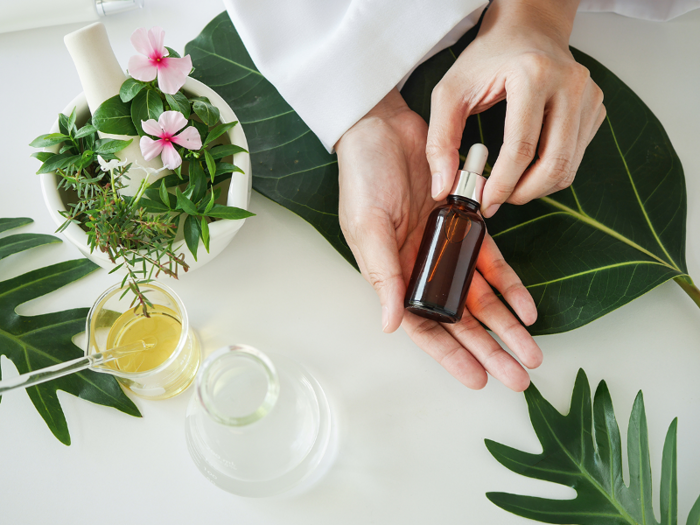
The right moisturizer can give you healthy, smooth, and soft skin. Here are our all-time favorites:
- Best moisturizer overall: CeraVe Moisturizing Cream
- Best facial moisturizer for under $25: Neutrogena Hydro Boost
- Best drugstore facial moisturizer for oily skin: La Roche-Posay Effaclar Mat
- Best inexpensive organic facial moisturizer: Pacifica Coconut Probiotic Water Rehab Cream
- Best drugstore body moisturizer for very dry skin: Vaseline Intensive Care Advanced Repair Unscented Lotion
- Best inexpensive moisturizer for very sensitive skin: Vanicream Moisturizing Skin Cream
- Best moisturizer with clean ingredients: Nécessaire Body Lotion
- Best antiaging facial moisturizer for less than $25: Olay Regenerist Micro-Sculpting Cream
- Best drugstore hand cream: Aveeno Active Naturals Skin Relief Hand Cream
Let's face it, there's nothing you can do about getting older, but you can delay the signs of aging with a good serum. Here are our top picks for the best anti-aging serums you can buy:
- Best serum overall: Clinique Smart Custom-Repair Serum
- Best serum on a budget: Olay Regenerist Micro Sculpting Anti-aging Serum
- Best serum to splurge on: Skinceuticals C E Ferulic Serum
- Best all-natural serum: Juice Beauty Stem Cellular Anti-Wrinkle Booster Serum
- Best serum for acne-prone skin: Instanatural Age-defying Skin Clearing Serum
Popular Right Now
Popular Keywords
Advertisement